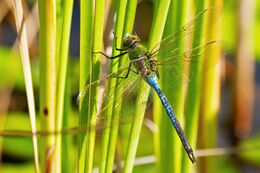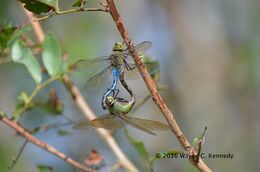Green Darner: Difference between revisions
No edit summary |
|||
| (9 intermediate revisions by 2 users not shown) | |||
| Line 1: | Line 1: | ||
The Common Green Darner, also known as ''Anax | The Common Green Darner, also known as ''Anax Junius'', is a type of insect more commonly known as the dragonfly [1]. The Greek translation of ''Anax Junius'' means 'Lord of June' [1]. This species is considered to be larger than most, and can be spotted flying over top of open fields [2]. They are referred to as 'Darners' because it was old belief that dragonflies were the 'Devil's Darning Needles', and that they could sew people's mouths shut [3]. | ||
[[File:GreenDarner.jpg|260px|thumb|left|This is a photo of an adult Green Darner.]] | [[File:GreenDarner.jpg|260px|thumb|left|This is a photo of an adult Green Darner.]] | ||
==Description== | ==Description== | ||
[[File:GreenDarnerDiagram.gif|260px|thumb| | [[File:GreenDarnerDiagram.gif|260px|thumb|right|This photo shows the anatomy of an adult Green Darner.]] | ||
The Green Darner can grow up to 8cm in length, having a short thorax and a long skinny abdomen [2]. Both males and females have large green eyes for navigating and hunting, but males tend to have duller colored eyes [2]. As they are considered [[insects]], they possess six legs, 3 on each side [2]. They | The Green Darner can grow up to 8cm in length, having a short thorax and a long skinny abdomen [2]. Both males and females have large green eyes for navigating and hunting, but males tend to have duller colored eyes [2]. As they are considered [[insects]], they possess six legs, 3 on each side [2]. They possess four translucent yellowish-clear wings that connect to their thorax [2]. All Green Darner's have a bright green thorax that connects to two wings on each side [1]. Males and females are typically distinguished by their abdomen color [1]. Female Darner's have a dark reddish brown abdomen, whereas males will have strictly bright blue abdomens [2]. | ||
==Distribution== | ==Distribution== | ||
| Line 15: | Line 15: | ||
==Habitat== | ==Habitat== | ||
Since the Green Darner is a migratory insect it can be found in many varying habitats [2]. Adult Darners are typically found in riparian habitats, because they heavily | Since the Green Darner is a migratory insect it can be found in many varying habitats [2]. Adult Darners are typically found in riparian habitats, because they heavily rely on water for reproduction [2]. Sometimes Darners will live on the water they original spawned from [2]. While migrating they will make use of coast lines and beaches for temporary habitat [2]. At night they are often found resting in herbaceous plants [2]. During the day they may forage for food in forests, grasslands, or deserts, but must be near a water source at all times [2]. | ||
==Diet== | ==Diet== | ||
[[File:GreenDarnerNymphLabium.jpg|260px|thumb|right|This photo shows the labium of a Green Darner nymph.]] | |||
Green Darners are carnivores, eating insects and other 'small' [[organisms]] [2]. During their nymph stage they will eat zooplankton, tadpoles, and even small fish [2]. These nymphs' have a labium which is a specialized part that launches out of their mouth and latches onto prey [2]. Once it catches the prey it will retract into their mandibles and then the prey will be eaten [2]. Adult Darners will eat flies, gnats, moths, butterflies, mayflies, damselflies, mosquitos, and sometimes smaller dragonflies [1]. | |||
==Reproduction== | ==Reproduction== | ||
[[File:GreenDarnerWheelPosition.jpg|260px|thumb|left|This photo shows two adult Green Darners in Wheel Position.]] | |||
Mating season typically begins in the mid to late summer, but can differ from population to population [2]. The mating process is started when a male darner grabs the head of the female [2]. If the female approves of the male, they will then fly away from the water source and land on nearby vegetation [2]. The male will then transfer his sperm into the female's genital opening [2]. During this process the female will use her legs to latch onto the male, this is known as the 'wheel position' [2]. This species is polygynandrous, which means that both genders will mate multiple times with multiple different partners [2]. Once mating is finished, the pair will fly down to the water together and lay their eggs on the floating vegetative material [2]. The clutch size of the Common Green Darner is not yet reported, but both males and females take three to twelve months to reach sexual maturity [2]. | |||
---- | |||
==References== | ==References== | ||
| Line 28: | Line 37: | ||
[3] Not Green Darners (Family Aeshnidae). 2011, October 11. . | [3] Not Green Darners (Family Aeshnidae). 2011, October 11. . | ||
---- | |||
Images | ==Images== | ||
1. https://www.istockphoto.com/search/2/image?phrase=green+darner | 1. https://www.istockphoto.com/search/2/image?phrase=green+darner | ||
2. https://www.enchantedlearning.com/subjects/insects/dragonfly/ | 2. https://www.enchantedlearning.com/subjects/insects/dragonfly/Dragonfly | ||
printout.shtml | |||
3. https://www.discoverlife.org/mp/20q?search=Anax+junius | 3. https://www.discoverlife.org/mp/20q?search=Anax+junius | ||
4. http://lifeinfreshwater.net/dragonfly-nymphs-odonata-anisoptera/#more-146 | |||
5. https://www.flickr.com/photos/waynekennedy/30906398456/ | |||
---- | |||
Latest revision as of 16:11, 11 May 2022
The Common Green Darner, also known as Anax Junius, is a type of insect more commonly known as the dragonfly [1]. The Greek translation of Anax Junius means 'Lord of June' [1]. This species is considered to be larger than most, and can be spotted flying over top of open fields [2]. They are referred to as 'Darners' because it was old belief that dragonflies were the 'Devil's Darning Needles', and that they could sew people's mouths shut [3].

Description

The Green Darner can grow up to 8cm in length, having a short thorax and a long skinny abdomen [2]. Both males and females have large green eyes for navigating and hunting, but males tend to have duller colored eyes [2]. As they are considered insects, they possess six legs, 3 on each side [2]. They possess four translucent yellowish-clear wings that connect to their thorax [2]. All Green Darner's have a bright green thorax that connects to two wings on each side [1]. Males and females are typically distinguished by their abdomen color [1]. Female Darner's have a dark reddish brown abdomen, whereas males will have strictly bright blue abdomens [2].
Distribution

The Green Darner is one of the most prevalent dragonfly species in North America [1]. They are found all across the United States, and populations are even found in Southern Canada and Mexico [2]. During the winter season in the Northern Hemisphere, Darners will migrate south to survive cold conditions [2]. During these months populations can be found in the Yucatan, Belize, Veracruz, Hawaii, and Tahiti [2]. During migration they are often blown off course by the wind and can end up in random regions of the world, but so far have not established any invasive populations [2].
Habitat
Since the Green Darner is a migratory insect it can be found in many varying habitats [2]. Adult Darners are typically found in riparian habitats, because they heavily rely on water for reproduction [2]. Sometimes Darners will live on the water they original spawned from [2]. While migrating they will make use of coast lines and beaches for temporary habitat [2]. At night they are often found resting in herbaceous plants [2]. During the day they may forage for food in forests, grasslands, or deserts, but must be near a water source at all times [2].
Diet

Green Darners are carnivores, eating insects and other 'small' organisms [2]. During their nymph stage they will eat zooplankton, tadpoles, and even small fish [2]. These nymphs' have a labium which is a specialized part that launches out of their mouth and latches onto prey [2]. Once it catches the prey it will retract into their mandibles and then the prey will be eaten [2]. Adult Darners will eat flies, gnats, moths, butterflies, mayflies, damselflies, mosquitos, and sometimes smaller dragonflies [1].
Reproduction

Mating season typically begins in the mid to late summer, but can differ from population to population [2]. The mating process is started when a male darner grabs the head of the female [2]. If the female approves of the male, they will then fly away from the water source and land on nearby vegetation [2]. The male will then transfer his sperm into the female's genital opening [2]. During this process the female will use her legs to latch onto the male, this is known as the 'wheel position' [2]. This species is polygynandrous, which means that both genders will mate multiple times with multiple different partners [2]. Once mating is finished, the pair will fly down to the water together and lay their eggs on the floating vegetative material [2]. The clutch size of the Common Green Darner is not yet reported, but both males and females take three to twelve months to reach sexual maturity [2].
References
[1] Common Green Darner | Department of Entomology. (n.d.). . https://entomology.umn.edu/common-green-darner.
[2] Miner, A. (n.d.). Anax junius. https://animaldiversity.org/accounts/Anax_junius/.
[3] Not Green Darners (Family Aeshnidae). 2011, October 11. .
Images
1. https://www.istockphoto.com/search/2/image?phrase=green+darner
2. https://www.enchantedlearning.com/subjects/insects/dragonfly/Dragonfly printout.shtml
3. https://www.discoverlife.org/mp/20q?search=Anax+junius
4. http://lifeinfreshwater.net/dragonfly-nymphs-odonata-anisoptera/#more-146
5. https://www.flickr.com/photos/waynekennedy/30906398456/